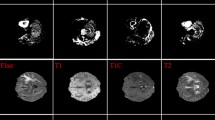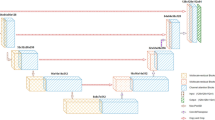Abstract
The magnetic resonance images (MRI) brain tumor segmentation is one of the most difficult medical images segmentation, and it has many challenges because the tumor has no specific shape or size, not found in a specific place of the brain and contains three sub-regions (full tumor FT, tumor core TC, and enhanced tumor ET). The manual segmentation is extremely difficult and prone to mistakes. In this research, the semantic segmentation is used by implementing the U-net model, which is a fully convolutional network (FCN) algorithm on BraTS 2018 that contains four modalities (T1, T2, T1c, Flair). The U-net model is used two time: The first is using 9-layers U-net with some enhancements on the original model for segment the full tumor, and the second is using 7-layers U-net model for segment the tumor core and enhanced tumor. The results were promised by segmenting the brain tumor within three sub-regions (full tumor, tumor core, and enhanced tumor), and the results were evaluated using standard brain tumor segmentation metrics. The proposed system achieves mean dice similarity coefficient metric; it is 0.87, 0.76, and 0.71 for full tumor, tumor core, and enhanced tumor, respectively. Additionally, the median dice similarity coefficient metric is 0.90, 0.84, and 0.80 for full tumor, tumor core, and enhanced tumor, respectively.
Access this chapter
Tax calculation will be finalised at checkout
Purchases are for personal use only
Similar content being viewed by others
References
Balafar MA, Ramli AR, Saripan MI, Mashohor S (2010) Review of brain MRI image segmentation methods. Artif Intell Rev 33(3):261–274
Ben naceur M, Saouli R, Akil M, Kachouri R (2018) Fully automatic brain tumor segmentation using end-to-end incremental deep neural networks in MRI images. Comput Methods Programs Biomed 166:39–49
Wang, G, Li W, Ourselin S, Vercauteren T (2019) Automatic brain tumor segmentation using convolutional neural networks with test-time augmentation. In: BT—Brainlesion: Glioma, Multiple Sclerosis, Stroke and Traumatic Brain Injuries, pp 61–72
Gholami A et al (2018) A novel domain adaptation framework for medical image segmentation. In International MICCAI Brainlesion workshop, pp 289–298
Myronenko A (2019) 3D MRI brain tumor segmentation using autoencoder regularization. In: Lecture Notes in Computer Science (including subseries Lecture Notes in Artificial Intelligence and Lecture Notes in Bioinformatics), LNCS, vol 11384, pp 311–320
Weninger L, Rippel O, Koppers S, Merhof D (2019) Segmentation of brain tumors and patient survival prediction: methods for the BraTS 2018 challenge. In: BT—Brainlesion: Glioma, multiple sclerosis, stroke and traumatic brain injuries, pp 3–12
Bakas S, Reyes M, Jakab A, Bauer S, Rempfler M, Crimi A, Takeshi Shinohara R, Berger C, Ha SM, Rozycki M, Prastawa M, Alberts E, Lipkova J, Freymann J, Kirby J, Bil M (2019) Identifying the best machine learning algorithms for brain tumor segmentation, progression assessment, and overall survival prediction in the BRATS challenge, vol v3. arXiv.org
Marcinkiewicz M, Nalepa J, Lorenzo PR, Dudzik W, Mrukwa G (2019) Segmenting brain tumors from MRI using cascaded multi-modal U-nets. In: BT—Brainlesion: Glioma, multiple sclerosis, stroke and traumatic brain injuries, pp 13–24
Kori A, Soni M, Pranjal B, Khened M, Alex V, Krishnamurthi G (2019) Ensemble of fully convolutional neural network for brain tumor segmentation from magnetic resonance images. In: Brainlesion: Glioma, multiple sclerosis, stroke and traumatic brain injuries, pp 485–496
Benson E, Pound MP, French AP, Jackson AS, Pridmore TP (2019) Deep hourglass for brain tumor segmentation. In: Brainlesion: Glioma, multiple sclerosis, stroke and traumatic brain injuries, pp 419–428
Carver E et al (2019) Automatic brain tumor segmentation and overall survival prediction using machine learning algorithms. In: Brainlesion: Glioma, multiple sclerosis, stroke and traumatic brain injuries, pp 406–418
Yang H-Y, Yang J (2019) Automatic brain tumor segmentation with contour aware residual network and adversarial training. In: Brainlesion: Glioma, multiple sclerosis, stroke and traumatic brain injuries, pp 267–278
Iqbal S, Ghani MU, Saba T, Rehman A (2018) Brain tumor segmentation in multi-spectral MRI using convolutional neural networks (CNN). Microsc Res Tech 81(4):419–427
Yu C, Wang J, Peng C, Gao C, Yu G, Sang N (2018) Learning a discriminative feature network for semantic segmentation. In: Proceedings of the IEEE conference on computer vision and pattern recognition, pp 1857–1866
Ronneberger O, Fischer P, Brox T (2015) U-net: convolutional networks for biomedical image segmentation. In: International conference on medical image computing and computer-assisted intervention, pp 234–241
Kolařík M, Burget R, Uher V, Říha K, Dutta MK (2019) Optimized high resolution 3D dense-U-Net network for brain and spine segmentation. Appl Sci 9(3):404
Leng J, Liu Y, Zhang T, Quan P, Cui Z (2019) Context-aware U-net for biomedical image segmentation
Tuan TA, Tuan TA, Bao PT (2019) Brain tumor segmentation using bit-plane and UNET. In: Brainlesion: Glioma, multiple sclerosis, stroke and traumatic brain injuries, pp 466–475
Author information
Authors and Affiliations
Corresponding author
Editor information
Editors and Affiliations
Rights and permissions
Copyright information
© 2021 The Author(s), under exclusive license to Springer Nature Singapore Pte Ltd.
About this paper
Cite this paper
Hmeed, A.R., Aliesawi, S.A., Jasim, W.M. (2021). Enhancement of the U-net Architecture for MRI Brain Tumor Segmentation. In: Kumar, R., Mishra, B.K., Pattnaik, P.K. (eds) Next Generation of Internet of Things. Lecture Notes in Networks and Systems, vol 201. Springer, Singapore. https://doi.org/10.1007/978-981-16-0666-3_28
Download citation
DOI: https://doi.org/10.1007/978-981-16-0666-3_28
Published:
Publisher Name: Springer, Singapore
Print ISBN: 978-981-16-0665-6
Online ISBN: 978-981-16-0666-3
eBook Packages: Intelligent Technologies and RoboticsIntelligent Technologies and Robotics (R0)




